We may earn revenue from the products available on this page and participate in affiliate programs. Learn more ›
Budget telescopes are a great way to dip your toes into cosmic exploration without needing a fortune of galactic proportions. While you may miss out on advanced tech and smart features found in more expensive options, budget-friendly telescopes still allow you to view stars, planets, nebulas, and more. Choosing an affordable telescope can be challenging, though. Read on to discover our favorite picks and what you should look for in the best budget telescopes.
Best overall: Celestron StarSense Explorer DX 130AZ
Best portable: Celestron Astromaster 70AZ
Best for smartphone astrophotography: Celestron Inspire 100AZ
Best for kids: Orion Observer II
Best for deep space: Sky-Watcher Classic 200
How we chose the best budget telescopes
While budget telescopes will result in limited selection compared to higher-price items, there are still plenty of options for those on tight budgets. When selecting the telescopes for this guide, we prioritized those from well-established brands to ensure quality, durability, and reliability. You’ll notice that Celestron is well-represented, and for good reason. Celestron is truly the heavy in the consumer telescope world, and it tends to dominate on the more accessible end of the spectrum. We then considered the optical design, mount type, aperture, and focal length, choosing a variety of options suitable for different stargazing needs. Finally, we assessed build quality, optical quality, and included accessories.
The best budget telescopes: Reviews & Recommendations
Manufacturers of budget telescopes inherently need to make sacrifices to keep prices down, but that doesn’t mean all budget-friendly devices are cheaply made or of poor quality. The options below will offer a balance of quality, features, and price so you can get the most for your money at a lower price point.
Best overall: Celestron StarSense Explorer DX 130AZ
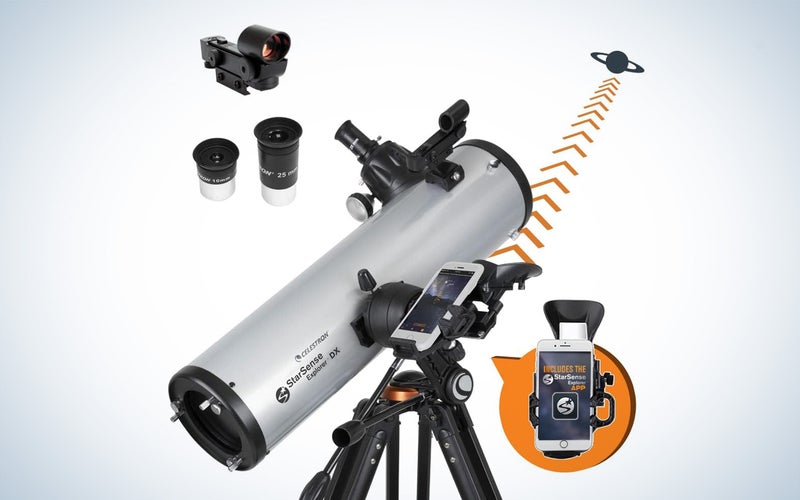
Specs
Optical design: Newtonian reflector
Mount type: Alt-azimuth
Aperture: 130mm (5.11 inches)
Focal length: 650mm (25.59 inches)
Magnification: 26x and 65x
Weight: 18 pounds
Dimensions: 38.98 x 16.93 x 8.98 inches
Pros
Easy to set up and align
Sharp, quality optics
Bright aperture
Excellent value for the price
Cons
Manual control only
Included eyepieces offer limited magnification
Our top pick offers an impressive amount of quality for its sub-$500 price. This Newtonian reflector telescope features a 5-inch primary mirror with highly reflective coatings to produce sharp, clear images. The 130mm aperture gatherers lots of light, so it’s plenty bright in many conditions. Those light-gathering skills also come in handy when taking photos if you want to practice astrophotography.
This budget telescope comes with an alt-azimuth mount and a sturdy, full-height tripod. Despite its robust base, it’s still relatively lightweight, so bringing it to a spot with less light pollution won’t be too challenging. It also includes 10mm and 25mm eyepieces, offering 26x and 65x magnification, respectively. That makes seeing star clusters, nebulae, planets, and more possible.
We especially like that the 130AZ comes with a phone deck. With your phone mounted to the telescope, you can use the StarSense app to identify which objects you want to look at. It will then guide you to where you need to be, which is fun for beginners and more experienced stargazers alike. If you want to use it without your phone, it also has a red dot finderscope to help guide you.
Best portable: Celestron Astromaster 70AZ
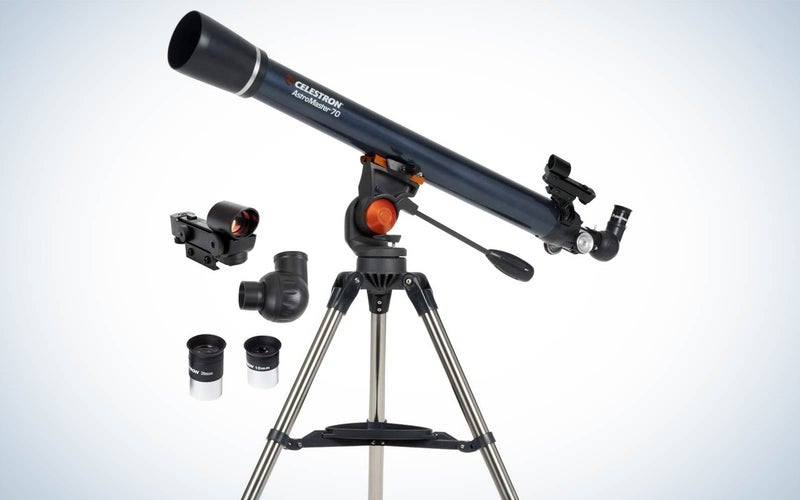
Specs
Optical design: Newtonian reflector
Mount type: Alt-azimuth
Aperture: 70mm (2.76 inches)
Focal length: 900mm (35 inches)
Magnification: 45x and 90x
Weight: 18 pounds
Dimensions: 14.96 x 5.12 x 3.94 inches
Pros
Includes everything you need to get started
Comes with 10mm and 20mm eyepieces
Very simple to set up
Lightweight and portable
Cons
Manual control only (no motor)
Limited magnification
The Celestron Astromaster 70AZ Newtonian reflector is an extremely popular budget telescope thanks to its ideal balance of features, size, and price. It comes with an alt-azimuth mount and two eyepieces—10mm and 20mm—so you won’t need to purchase any extras to get started viewing the stars. It’s also easy to assemble, so you’ll be stargazing just a few minutes after opening the box.
We like the Astromaster 70AZ partly because it is relatively compact and lightweight at roughly 18 pounds. It’s easier to bring with you on trips to find skies free of light pollution. The lightweight design also makes it a good choice for kids. The two eyepieces allow for 45x and 90x magnification, allowing you to view planets easily.
Of course, as a budget telescope, there are some downsides. The 70mm aperture won’t allow you to see deep-space objects very well. And the panning handle doesn’t allow for very precise adjustments. It’s best for beginners, as a result. But, it provides quality optics at a very affordable price, making it an attractive option for those on a tight budget.
Best for smartphone astrophotography: Celestron Inspire 100AZ
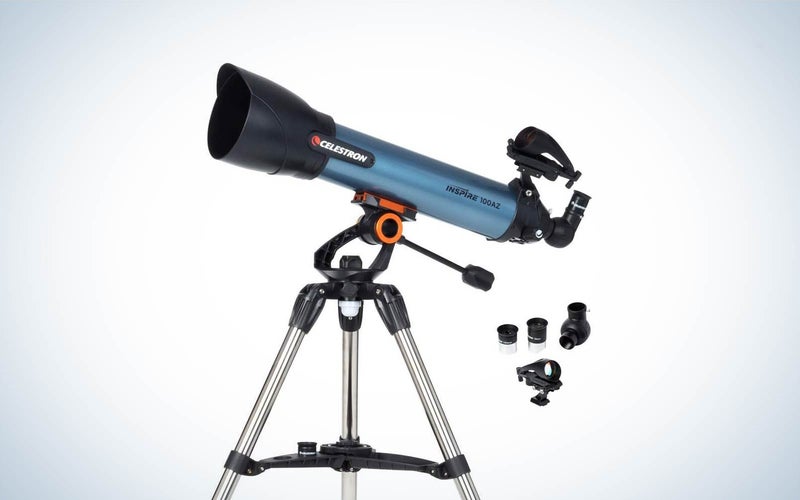
Optical design: Refractor
Mount type: Alt-azimuth
Aperture: 100mm (3.94 inches)
Focal length: 660mm (25.98 inches)
Magnification: 33x and 66x
Weight: 6.6 pounds
Dimensions: 38 x 33 x 52 inches
Pros
Quality optics
Lightweight and portable
Very easy to set up
Lens cap serves as a smartphone mount
Cons
Some fringing
The Celestron Inspire 100AZ is a great choice for those wanting to explore the possibilities of astrophotography with just a phone. That’s in part thanks to the clever dual-purpose lens cap. When you’re ready to take photos, simply attach the lens cap to the eyepiece, then strap your phone into place, and you’re all set.
The Inspire 100AZ is an achromatic refractor scope. It offers a 100mm aperture for plenty of light gathering and a 660mm focal length. You’ll be able to view the moon and planets easily and some brighter star clusters. It won’t quite cut it for deep space, however. That’s typical of this type of telescope.
This budget telescope features an alt-azimuth mount and comes with a sturdy tripod. It’s quick and easy to set up and break down. You’ll also get the StarPointer Pro red dot finder to help you find celestial objects and 10mm and 20mm Kellner eyepieces. And it offers a built-in red light to help you find your accessories in the dark without blasting your eyes with light. Unfortunately, there is some fringing, which is unsurprising for a budget refractor model. But for those just getting started, we think it’s still an excellent option.
Best for kids: Orion Observer II
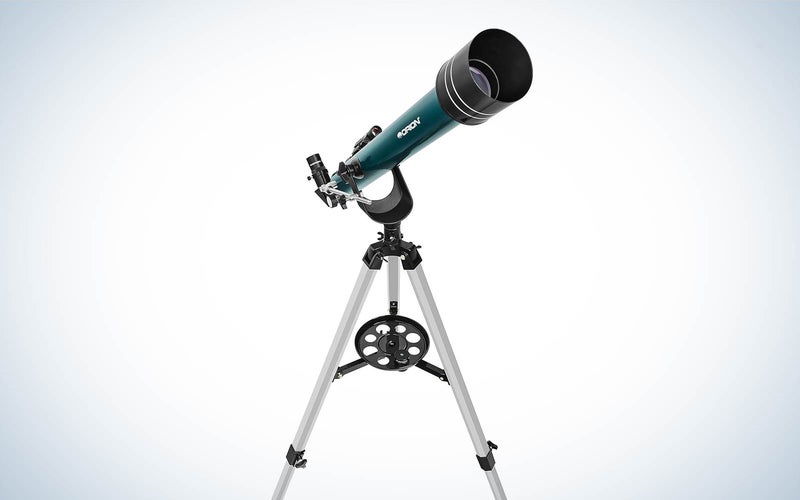
Optical design: Refractor
Mount type: Alt-azimuth
Aperture: 60mm (2.4 inches)
Focal length: 700mm (27.5 inches)
Magnification range: 28x, 70x
Weight: 4.3 pounds
Dimensions: 29.3 x 10.9 x 7.5 inches
Pros
Lightweight and portable
Comes with fun and useful books and maps
Includes two eyepieces
Easy to set up
Cons
Not for viewing deep space
If a star projector piqued your child’s interest in the cosmos, a to-scale telescope is a logical next step to keep their interest growing. The Orion Observer II is a great starter kit for kids. It will allow them to check out craters on the moon or even the rings on Saturn, expanding their minds as they view our vast universe.
The anti-reflection-coated 60mm achromatic objective lens gathers enough light for budding astronomers and produces clear views while keeping the cost down. The 700mm focal length paired with the included 10mm and 25mm Kellner eyepieces result in 28x and 70x magnification, respectively. It features an alt-azimuth mount for easy tracking and comes with a tripod that’s easy to set up, even for kids.
Part of what makes the Orion Observer II stand out for kids is the books and guides that come with it. The Orion MoonMap 260 shares 260 interest features to look for on the moon. The Star Target planisphere helps you figure out what you can see in the night sky for every night of the year. And the Exploring the Cosmos book introduces space and the stars for your budding astronomer.
Best for deep space: Sky-Watcher Classic 200
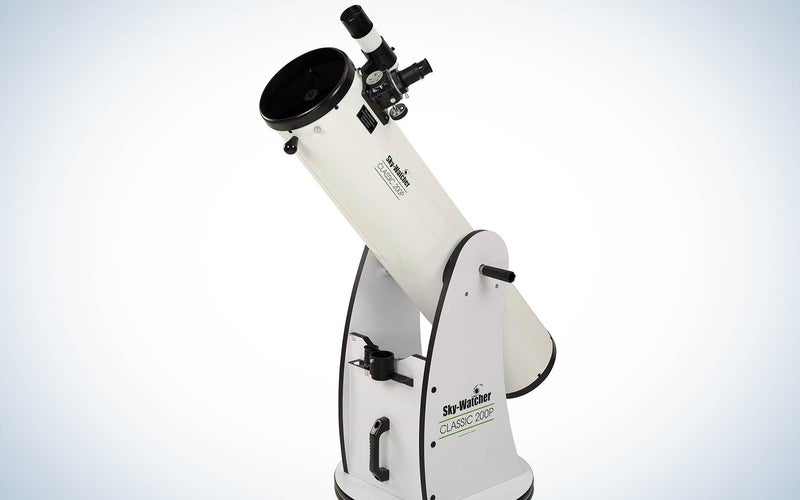
Optical design: Dobsonian
Mount type: Alt-azimuth
Aperture: 8 inches
Focal length: 1200mm
Magnification range: 48x, 120x
Weight: 45 pounds
Dimensions: 49 x 27 x 18 inches
Pros
8-inch mirror captures lots of light
Sharp, clear optics
Comes with 25mm and 10mm eyepieces
Sturdy and well-made
Cons
Bulky and heavy
For viewing deep into the depths of space, you’ll need a telescope with lots of light-gathering abilities. That means a Dobsonian telescope, a type of telescopes commonly called “light buckets.” The Sky-Watcher Classic 200 is an excellent budget-friendly Dobsonian, offering a lot of quality for the price.
The large eight-inch aperture will allow you to view even faint nebulas, galaxies, and star clusters. The 1200mm focal length provides lots of reach, resulting in 48x and 120x magnification when using the included 10mm and 25mm Plössl eyepieces. It also comes with a two-inch Crayford focuser, a 1.25-inch eyepiece adapter, and a 9×50 straight-through finder scope. There is a built-in eyepiece tray to keep it all organized as well, which we appreciate.
Sky-Watcher designed this scope with Teflon bearings for smooth azimuth movement and patented tension control handles for accurate adjustments. It is very well made and will last a lifetime. The main downside to this budget telescope is its size. It weighs 45 pounds when fully assembled. It also doesn’t come with a stand, so it must be placed on a sturdy, level surface. This telescope is not one that you will want to travel with or move around much as a result. Instead, it’s best suited for homes where you can set it up and leave it be.
There’s lots of technical jargon associated with telescopes, so figuring out what it all means can be overwhelming. We spoke with Dr. Jason Aufdenberg, Associate Professor of Astronomy and Astrophysics at Embry-Riddle Aeronautical University, to get his advice on telescope shopping. He explained that it may be tempting to opt for the largest magnification you can afford and ignore all the other features, but that’s not necessarily the right call. Below are some key things to pay attention to when choosing a budget telescope, or any telescope, for that matter.
Optical design
There are three primary types of optical designs in telescopes: Refractor, reflector, and catadioptric or compound.
Reflector telescopes use glass lenses to focus light into an eyepiece. Light needs to travel in a straight path to the eyepiece in reflectors, which results in devices that are longer than they are wide. Reflector telescopes tend to result in chromatic aberration, otherwise known as fringing. To avoid this, Dr. Aufdenberg explained that manufacturers rely on complicated multi-element lens systems, which makes them expensive. But they are sturdy and relatively maintenance-free, making them one of the most common types available.
Reflector telescopes—which include Dobsonian and Newtonian—use mirrors to reflect the light into focus. These bounce light back and forth in the optical tube, which allows for a shorter design. They also cost less to make, so most cheap telescopes are reflectors. Dr. Aufdenburd suggests a Dobsonian for beginners because it offers the most light collection per dollar. However, this type of telescope will require what’s called collimation, which is an alignment of the mirrors. It usually only takes a few minutes, but it is an additional step.
Finally, catadioptric telescopes use both lenses and mirrors, resulting in a compact form factor. If you’re looking for a portable option, a catadioptric is your best bet. Schmidt-Cassegrains and Maksutov-Cassegrains are two common varieties of this type of telescope.
Mount type
Dr. Aufdenberg stressed that the telescope mount is just as important as the other features. That’s because the mount controls how and where the telescope can move, which impacts what you can do with it. There are three primary types of mounts to consider: Alt-azimuth, Dobsonian, and equatorial.
Alt-azimuth mounts are the simplest and, thus, most affordable mounts available. These allow for altitude (vertical) and azimuth (horizontal) adjustments. Quality alt-az mounts allow for smooth tracking across the sky, which makes them an ideal choice for shorter astrophotography captures. Some are even computerized for automatic tracking.
Dobsonian mounts sit on lazy susan-like platforms that must be placed on sturdy surfaces like tables or mounted to platforms. They are intended to support massive Newtonian telescopes, but many compact telescopes also use this mount type as well. They provide more stability than the other mount types, as long as you have a stable surface to mount it to.
Equatorial mounts essentially counteract the Earth’s rotation, making them perfect for long observations and serious astrophotography. With an equatorial mount, you can focus on a specific celestial object and guide it across the sky to keep it centered. You can either do this manually or with an electric motor for automatic tracking.
Lens
Once you decide on your optical design and mount type, you’ll need to select the diameter of the primary lens, also known as aperture. The aperture is measured in millimeters or inches and indicates how much light the telescope lets in. A larger aperture will allow for shorter exposure times for astrophotography and allow you to see dimmer objects—such as nebulae—faster. You should choose the largest lens that you can afford and that is as portable as you need it to be.
Magnification
Lastly, you’ll want to think about the type of objects you want to view and what magnification is required to view those objects. To see details such as Jupiter’s moons or Saturn’s rings, you’ll want at least 30-40x magnification.
Magnification is, in part, determined by the focal length of your eyepiece. Many telescopes will come with multiple eyepieces, providing more versatility. To determine the magnification with a specific eyepiece, divide the focal length of the optical tube by the eyepiece.
FAQs
Q: Are cheap telescopes worth it?
Yes, depending on how cheap you are looking for, cheap telescopes are worth it. But if you go too cheap, it may not be. We’d recommend at least sticking above $100 for a telescope. Any cheaper, you’ll be dealing with poor-quality optics that make it difficult to see details and missing features that prevent you from easily finding and tracking celestial objects.
Q: Can a cheap telescope see planets?
Yes, you can use a cheap telescope to see planets. Cheap telescopes may not offer smart technology features such as finding and tracking planets automatically. But plenty of budget-friendly telescopes have enough reach and light-gathering abilities to check out planets.
Q: Which telescope brand is best?
Which telescope brand is best depends on what you are looking for and your budget, but Celestron, Orion, Sky-Watcher, Meade Instruments, Explore Scientific, and Vixen all make excellent, trustworthy telescopes. If you are looking for a smart telescope, Vaonis and Unistellar are two of the top options.
Q: Are used telescopes worth buying?
Used telescopes are very much worth buying. If in good condition, a used telescope will function just as well as a new one and will save you money.
Final thoughts on the best budget telescopes
Best overall: Celestron StarSense Explorer DX 130AZ
Best portable: Celestron Astromaster 70AZ
Best for smartphone astrophotography: Celestron Inspire 100AZ
Best for kids: Orion Observer II
Best for deep space: Sky-Watcher Classic 200
You don’t have to spend a fortune to get a quality, fun-to-use telescope. By prioritizing the features and technology that you will actually use, you’ll be able to save money while getting a device that will last you for years to come. Whether you are a novice to stargazing or someone with more experience, the budget telescopes above will get you searching the cosmos for less.
Why trust us
Popular Science started writing about technology more than 150 years ago. There was no such thing as “gadget writing” when we published our first issue in 1872, but if there was, our mission to demystify the world of innovation for everyday readers means we would have been all over it. Here in the present, PopSci is fully committed to helping readers navigate the increasingly intimidating array of devices on the market right now.
Our writers and editors have combined decades of experience covering and reviewing consumer electronics. We each have our own obsessive specialties—from high-end audio to video games to cameras and beyond—but when we’re reviewing devices outside of our immediate wheelhouses, we do our best to seek out trustworthy voices and opinions to help guide people to the very best recommendations. We know we don’t know everything, but we’re excited to live through the analysis paralysis that internet shopping can spur so readers don’t have to.
>>> Read full article>>>
Copyright for syndicated content belongs to the linked Source : Popular Science – https://www.popsci.com/gear/best-budget-telescopes/































